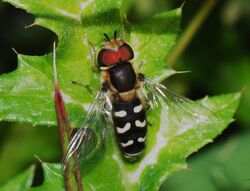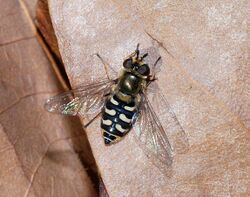Biology:Scaeva pyrastri
| Scaeva pyrastri | |
|---|---|

| |
| Male | |

| |
| Female | |
| Scientific classification | |
| Domain: | Eukaryota |
| Kingdom: | Animalia |
| Phylum: | Arthropoda |
| Class: | Insecta |
| Order: | Diptera |
| Family: | Syrphidae |
| Genus: | Scaeva |
| Species: | S. pyrastri
|
| Binomial name | |
| Scaeva pyrastri | |
| Synonyms[2][3] | |
Scaeva pyrastri, common name the pied hoverfly, is a species of hoverfly.[4]
Distribution
These hoverflies are present in most of Europe, the Near East, the East Palearctic realm, the Nearctic realm, North Africa, and the Indomalayan realm.[5] In the UK S. pyrastri is a migrant which arrives in some years in high numbers and in others is almost absent.[6]
Description
Scaeva pyrastri can reach a length of 11–15 millimetres (0.43–0.59 in).[7][8] This large distinctive fly has three pairs of white comma markings (lunules) on the abdomen,[7] these are yellow on Scaeva selenitica.
The face is yellow, with reddish brown antennae. The eyes are covered with hair. Scutellum is brown yellow. The legs are red with a black base of the femur. The male's eyes do touch in the centre of the frons, while in the females they are separated.
The larvae are light green or sometimes pink, with a white dorsal longitudinal stripe.[8][9]
Habitat and behavior
This species can be found in gardens, meadows and wasteland.[10] Adults are common visitors to flowers of Apiaceae (Umbelliferae), but also of rape, honeysuckle and daisies. They fly from April to September, with the peak in July and August.[7][10] The larvae feed on different aphid species.[9] During the larval stages they may consume over 500 aphids.[8]
Bibliography
- Gerald Bothe: Schwebfliegen. Deutscher Jugendbund für Naturbeobachtung, Hamburg 1996.
- Joachim and Hiroko Haupt: Fliegen und Mücken: Beobachtung, Lebensweise. Naturbuch-Verlag, Augsburg 1998, ISBN:3-89440-278-4.
- Kurt Kormann: Schwebfliegen und Blasenkopffliegen Mitteleuropas. Fauna Verlag, Nottuln 2003, ISBN:3-935980-29-9.
- R. Bugg et al. 2008. - Flower Flies (Syrphidae) and other biological control agents for aphids in vegetable crops - UC ANR Publication 8285.
- Thompson F.C., Pape T., Evenhuis N.L. (2013) Systema Dipterorum
References
- ↑ 1.0 1.1 Harris, M. (1780). An exposition of English insects. Decads III, IV. London: Robson Co.. pp. 73-99, 100-138, pls. 21-30, 31-40. https://www.biodiversitylibrary.org/item/226006#page/5/mode/1up. Retrieved 16 July 2021.
- ↑ " Scaeva pyrastri (Linnaeus, 1758)". https://www.biolib.cz/en/taxon/id96962/. Retrieved 10 July 2019.
- ↑ "Scaeva pyrastri (Linnaeus, 1758)". https://www.itis.gov/servlet/SingleRpt/SingleRpt?search_topic=TSN&search_value=140241#null. Retrieved 10 July 2019.
- ↑ Stubbs, Alan E.; Falk, Steven J. (1983). British Hoverflies: An Illustrated Identification Guide. British Entomological & Natural History Society. pp. 253, xvpp.
- ↑ Fauna europaea
- ↑ Ball, Stuart; Morris, Roger (2013). Britain's Hoverflies. An introduction to the hoverflies of Britain. Woodstock, Oxfordshire: Princeton University Press. pp. 114–5. ISBN 978-0-691-15659-0.
- ↑ 7.0 7.1 7.2 Nature in NRW
- ↑ 8.0 8.1 8.2 Bugguide
- ↑ 9.0 9.1 Aramel.free
- ↑ 10.0 10.1 Nature Spot
External links
Wikidata ☰ Q1424995 entry
 |



